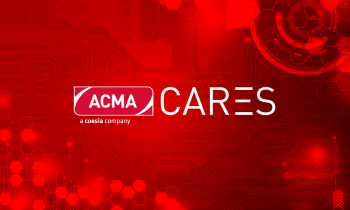Going digital: how ACMA is innovating its offer with AI and IoT
Business has always been about serving the customer, but now, even more so. From hospitals to industrial manufacturers, everyone is going digital. Ten years ago, though, that was marketing jargon for setting up a Facebook page. Today, with the wealth of options made available by the knowledge economy, going digital refers to a profound change not only of how companies communicate with their customers, but also of how they operate. Companies around the world are on the lookout for new solutions to expand their offer. Most forward-looking enterprises are turning to IoT and AI to rethink their business models and find new ways to serve their customers, both remotely and in presence. It is the Fourth Industrial Revolution, or Industry 4.0 - a massive transition from traditional manufacturing to Industrial IoT as a service. Computer Vision, Internet of Things technologies, and Edge Computing are the pillars on which the new economy is being built.
ACMA, a leading manufacturer of automatic packaging machines in the consumer goods market, is no stranger to this paradigm shift. The company, always looking for digital solutions to innovate its business, is redesigning its commercial offer around the changing economic landscape. Among the novelties, the most promising ones are Remote FAT, Remote Assistance, Predictive Maintenance, and a brand-new Human Machine Interface named OptiMate.
Remote FAT
The digital revolution affects not only commerce, but industries of all kinds. Thanks to video and live streaming, machinery producers can reinvent how they conduct standard procedures such as FAT. FAT stands for Factory Acceptance Testing, i.e. the official test taking place after purchase and agreed upon by the customer and the manufacturer. During FAT, both the customer and the manufacturer verify that the machinery is properly built and works in accordance with contractual arrangements. Usually, the customer inspects the machinery first-hand to get a sense of its performance. With Remote FAT, though, the customer can carry out Factory Acceptance Testing remotely.
Remote FAT offers three options: video, live streaming and interactive live streaming. Whatever the option, both parties first establish what is going to be tested during the procedure, and ACMA arranges the cameras accordingly.
As regards the first option, ACMA shoots a video showing the agreed upon test and sends it to the customer, so that he can comfortably watch it whenever it suits him best.
With the second option, the customer can log into a private live streaming virtual room and supervise the test as it takes place, yet without interaction with ACMA’s operators.
Finally, the third option enables the customer to be in constant contact with ACMA's operators and ask them to move the cameras as it sees fit, so as to closely inspect the most interesting areas of the machinery.
Remote Assistance
ACMA’s Remote Assistance stems from the need to streamline and optimize the customer experience as far as technical assistance is concerned. Compared to traditional technical assistance tools, ACMA’s Remote Assistance truly narrows the gap between the customer and ACMA’s technical service center by providing the former with visual and immediate support.
Remote Assistance is intended to help customers maximize their equipment uptime and productivity through a more efficient collaborative platform. Indeed, the platform is the real deal, as it encompasses a vast array of tools, including high-quality audio, video, file sharing and Augmented Reality. Remote Assistance is in fact the combination of 3 key elements: the IT platform, Hardware, and Knowledge. The former comprises the mobile app, a web portal, communication technology, and AR. Hardware refers to smart glasses, tablets, smartphones. Knowledge, on the other hand, refers to advanced diagnostics, real-time support, technical documentation, and troubleshooting instructions. All together these key elements ensure a faster and more effective diagnosis and troubleshooting, increasing the speed of resolution while reducing the operational costs.
Predictive Maintenance
Predictive Maintenance is the combined output of Big Data, Industrial IoT, and Artificial Intelligence. By enabling the factory with gateways and retrofittable sensors, it is possible to extract a huge amount of data from the machines, which can successively be mined through neural network algorithms. The result is a wealth of actionable insights about the machinery, such as expected lifetime cycle, power consumption and the likes. When you put it all together, you can predict with a reasonable certainty any future malfunctions of the machinery in question.
Such a piece of information is, of course, invaluable, as it increases equipment uptime, avoiding unplanned stop prevention and drastically improving productivity. In short, this is what is called Predictive Maintenance.
To further empower its customers, ACMA is developing a solution to equip its machines with more and more advanced IoT sensors for data collection. This implementation will allow ACMA to offer a Predictive Maintenance service to their customers, boosting their productivity with new AI-based services and tools. Indeed, with ACMA's Predictive Maintenance the customer will have real-time control over operations as well as real-time production data acquisition and management for entire fleets of machines. The customer will be able leverage the data to conduct performance analysis (OEE, loss tree, etc.) and cloud-based analytics, taking full advantage of the power of cloud, deep learning, and edge computing.
OptiMate
Human Machine Interfaces (HMI) have radically evolved over the years. From command lines to Augmented Reality, user interfaces have always been of paramount importance, as they are the main user experience enablers as well as proxies for business to customers interaction. One growing trend in HMI is human-centered design, i.e. the principle according to which any approach to problem solving must always come from a human-centered perspective. Friendly and intuitive designs, once perceived as nice-to-haves, are increasingly must-to-haves, as the more user-friendly the interface is, the less time it takes for the customer to learn how to use it at its best.
Within its commercial offer redesign, ACMA has also taken the opportunity to modernize its Human Machine Interface in line with these principles. ACMA’s new HMI codenamed OptiMate is designed to provide the customer with direct access to all key information at a glance.
A single dashboard encompasses production data, performance analysis, and main machine controls to run the machine without leaving the page. The information is all in one place, so as to spare the customer from bouncing back and forth from various sections of the documentation. Moreover, it is content-related, that is to say, not all information is provided at once, but only what is relevant to the task at hand.
Furthermore, notifications are clear: the system alerts the customer about machine status, scheduled maintenance, and alarms. The homepage gives full control, enabling smart navigation, guiding the customer hand-in-hand through changeover and maintenance, troubleshooting and custom procedures. It also provides video tutorials for maintenance and changeover. On top of that, the customer is provided with OEE & Production analysis, the top 10 alarms monitoring, and exportable reports.
Webshop
ACMA has always been at the forefront of innovation, launching its Webshop, i.e. a tailor-made online platform for ordering spare parts, as early as 2014.
Coesia Webshop is built with ease of use in mind. It consists in a clean and simple interface equipped with a photo catalog of options. It lets the customer search and select components in multiple ways. In fact, the customer can select replacements via part number or upload its shopping list from an XML file. Afterwards, it can verify the order through visual identification of the components and successively save, download or finalize the order. What’s more, Coesia Webshop keeps track of all current and past orders and inquiries. Being integrated with the company ERP, spare parts’ availability is updated in real-time.
In conclusion, ACMA’s cutting-edge solutions are perfectly positioned to face the challenge of the digital revolution. This is not by chance. On the contrary: ACMA has been developing these tools for a long time, and is thereby fully prepared to manage the transition, as well as to step on the gas when necessary, strengthening these tools even further. With state-of-the-art technologies such as AI, IoT, Edge Computing, Computing Vision, and AR, ACMA’s commercial offer is at the forefront of innovation among industrial manufacturers worldwide.
Looking for digital solutions to raise your business to a whole new level? Get in touch!



